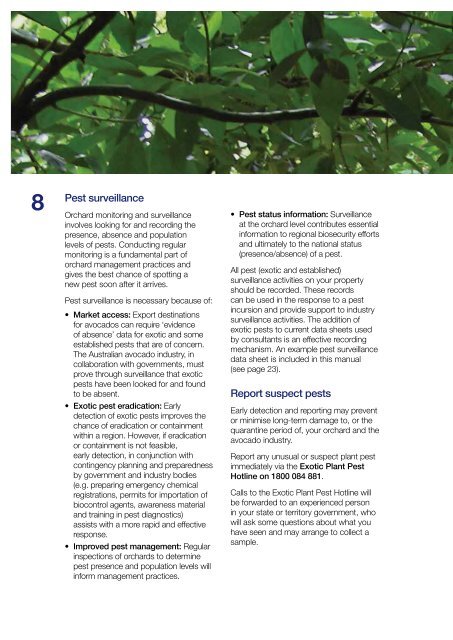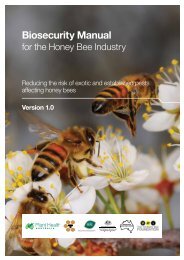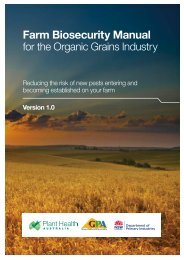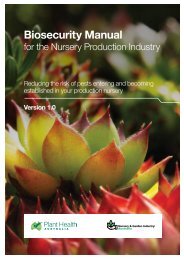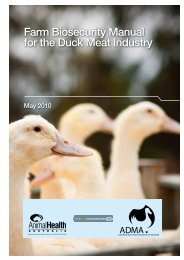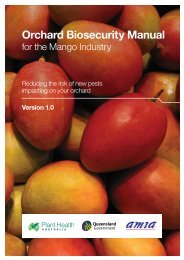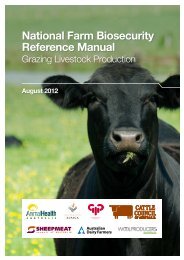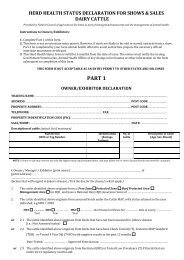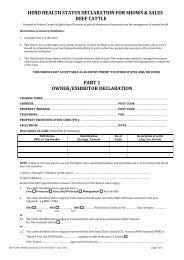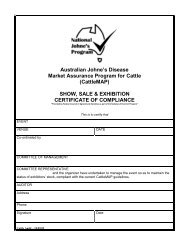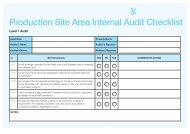Orchard Biosecurity Manual for the Avocado ... - Farm Biosecurity
Orchard Biosecurity Manual for the Avocado ... - Farm Biosecurity
Orchard Biosecurity Manual for the Avocado ... - Farm Biosecurity
Create successful ePaper yourself
Turn your PDF publications into a flip-book with our unique Google optimized e-Paper software.
Pest surveillance 8 • Pest status in<strong>for</strong>mation: Surveillance<br />
<strong>Orchard</strong> monitoring and surveillance<br />
involves looking <strong>for</strong> and recording <strong>the</strong><br />
presence, absence and population<br />
levels of pests. Conducting regular<br />
monitoring is a fundamental part of<br />
orchard management practices and<br />
gives <strong>the</strong> best chance of spotting a<br />
new pest soon after it arrives.<br />
Pest surveillance is necessary because of:<br />
• Market access: Export destinations<br />
<strong>for</strong> avocados can require ‘evidence<br />
of absence’ data <strong>for</strong> exotic and some<br />
established pests that are of concern.<br />
The Australian avocado industry, in<br />
collaboration with governments, must<br />
prove through surveillance that exotic<br />
pests have been looked <strong>for</strong> and found<br />
to be absent.<br />
• Exotic pest eradication: Early<br />
detection of exotic pests improves <strong>the</strong><br />
chance of eradication or containment<br />
within a region. However, if eradication<br />
or containment is not feasible,<br />
early detection, in conjunction with<br />
contingency planning and preparedness<br />
by government and industry bodies<br />
(e.g. preparing emergency chemical<br />
registrations, permits <strong>for</strong> importation of<br />
biocontrol agents, awareness material<br />
and training in pest diagnostics)<br />
assists with a more rapid and effective<br />
response.<br />
• Improved pest management: Regular<br />
inspections of orchards to determine<br />
pest presence and population levels will<br />
in<strong>for</strong>m management practices.<br />
at <strong>the</strong> orchard level contributes essential<br />
in<strong>for</strong>mation to regional biosecurity ef<strong>for</strong>ts<br />
and ultimately to <strong>the</strong> national status<br />
(presence/absence) of a pest.<br />
All pest (exotic and established)<br />
surveillance activities on your property<br />
should be recorded. These records<br />
can be used in <strong>the</strong> response to a pest<br />
incursion and provide support to industry<br />
surveillance activities. The addition of<br />
exotic pests to current data sheets used<br />
by consultants is an effective recording<br />
mechanism. An example pest surveillance<br />
data sheet is included in this manual<br />
(see page 23).<br />
Report suspect pests<br />
Early detection and reporting may prevent<br />
or minimise long-term damage to, or <strong>the</strong><br />
quarantine period of, your orchard and <strong>the</strong><br />
avocado industry.<br />
Report any unusual or suspect plant pest<br />
immediately via <strong>the</strong> Exotic Plant Pest<br />
Hotline on 1800 084 881.<br />
Calls to <strong>the</strong> Exotic Plant Pest Hotline will<br />
be <strong>for</strong>warded to an experienced person<br />
in your state or territory government, who<br />
will ask some questions about what you<br />
have seen and may arrange to collect a<br />
sample.


